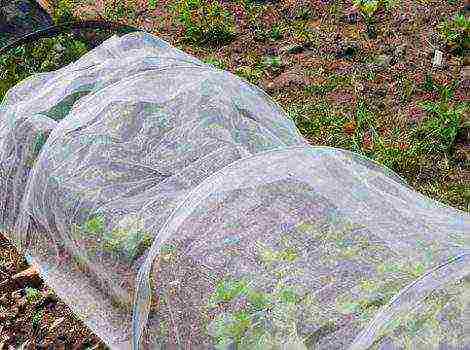Content
- 1 Growing pansies in a pot
- 2 With your own hands
- 3 Growing from seeds
- 4 Seedling
- 5 Care advice
- 6 When do they bloom?
- 7 Diseases
- 8 Useful video
- 9 Description of pansy flowers
- 10 Variety of varieties of pansies (review)
- 11 How to grow pansies
- 12 Choosing a place for flowers
- 13 Open ground: cultivation features
- 14 How to grow pansy seedlings?
- 15 Growing pansies on the balcony
- 16 How to care for pansies?
- 17 What fertilizers are suitable for flowers
- 18 Several important nuances in the care of a viola
- 19 Heading "Questions and Answers"
Pansies can undoubtedly be considered one of the most common and beloved plants by millions of flower growers around the world. This vibrant culture is beautiful for its miniature size, variety of flower colors and high decorativeness. Pansies are widely used to compose all kinds of flower arrangements, grown in the garden and indoors.
Pansies (Viola tricolor) or Violet tricolor - undersized (up to 30 cm), herbaceous plant of the Violet family. In culture, it is used as a biennial or annual. In its natural environment, it grows in Asia and Europe. The plant is famous for its early and abundant flowering. On a very young shrub that did not have time to properly spread out, rather large flowers appear in large quantities. In the harsh climate of Russia, pansies, which are sown from seeds, can bloom in mid-spring.
Modern breeders have developed a huge number of varieties of pansies, which differ in color and varietal qualities. May be suitable for outdoor cultivation as well as pot keeping.
In this article, we'll go over the basics of growing and caring for pansies at home.
Growing pansies in a pot
Planting seeds
Growing pansies from seeds is pretty easy. Violet tricolor is unpretentious and can be used as an annual or biennial plant. It is best to choose the time of planting violet seeds, focusing on the date of the desired flowering. If sowing is done at the end of winter, flowering will come already this year. If you plan to keep the violet as a two-year crop, it is best to plant the seeds in early summer.
Seeds should be picked from a specialist store. On the packaging you will see all the necessary information about the varietal qualities and learn about the suitability of the seeds for pot cultivation. Pansy seeds are planted in seed boxes or pots, depending on the desired number of future plants. The substrate can be used universal, floral, or composed of leafy, turfy soil and compost in equal proportions. Before sowing, the soil is slightly moistened, the seeds are sown in the grooves and lightly sprinkled with earth from above. Seeds must not be buried more than 1.5 cm.
Seedlings appear with regular, sufficient watering at room temperature. After sprouting, plant pots should be placed on a sunny windowsill. The grown seedlings dive over time in pots and grow on a windowsill or on a balcony.
Pansy Care
- If the pansies receive too much direct, bright sunlight, the bloom will be intense, abundant, but not long lasting. If you place the plant in a place with diffused but intense lighting, the flowering will be less lush, but it will last much longer.
- Watering the plant is done with soft water, often and abundantly in the summer. When the air temperature drops, pansies are watered moderately, with caution. Do not forget about the need to drain excess water from the sump.
- Pansies don't like too much heat. An increase in temperature above +20 degrees inhibits plant growth. This especially affects negatively in the initial phase of seedling growth.
- For bright and intense flowering, the tricolor violet is fed with flower fertilizer according to the manufacturer's scheme.
- To keep blooming for as long as possible, wilted flowers should be plucked, this will help provide energy for the formation of new buds.
- Often potted pansy produces seeds that can be harvested after ripening and used for sowing.
- If you're growing the plant as an annual, just throw away the pansies after flowering.
- Inspect the tricolor violet regularly. Its leaves are often attacked by aphids, which are easy to fight with a fungicide.
Pansies photos
 Viola (garden violet) is a plant worth getting to know for novice amateur flower growers. Viola flowers are similar to bright summer butterflies, with wings of red, blue, yellow, white, black shades. Some varieties, planted in groups, resemble funny faces from afar. If you look at such a flower close up, you can clearly see in its center a bright yellow eye, framed by strokes-cilia. For this similarity among the people, some viols (or, to be more precise, tricolor violets and Wittrock's viols) are called pansies.
Viola (garden violet) is a plant worth getting to know for novice amateur flower growers. Viola flowers are similar to bright summer butterflies, with wings of red, blue, yellow, white, black shades. Some varieties, planted in groups, resemble funny faces from afar. If you look at such a flower close up, you can clearly see in its center a bright yellow eye, framed by strokes-cilia. For this similarity among the people, some viols (or, to be more precise, tricolor violets and Wittrock's viols) are called pansies.
To begin with, in order to grow such a miracle on the balcony or in the garden, you need to purchase seedlings or grow viola from seeds yourself. And then, in order for the viola to bloom and delight you all summer and autumn, learn how to properly care for it. All the nuances about growing viola on the balcony and in the garden, read on.
The nature of the viola: what conditions are necessary for growth and flowering?
If you want to know how to grow viola, then pay attention to its character.
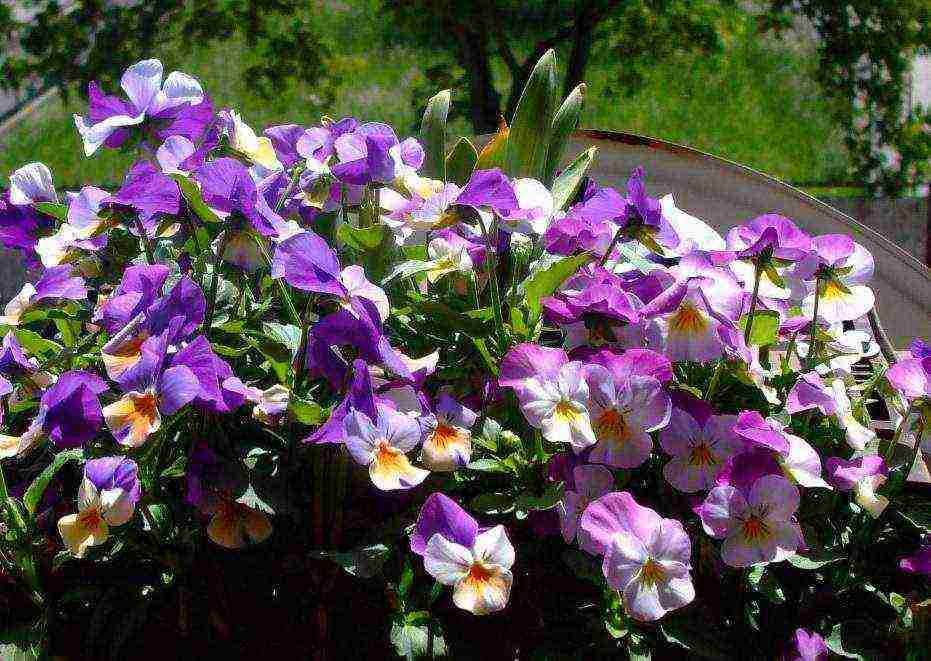 Pansies are a problem-free plant that blooms profusely on balconies and flower beds
Pansies are a problem-free plant that blooms profusely on balconies and flower beds
Viola is not capricious, but you also need to be able to find an approach to her. Viola care assumes compliance with the following factors:
1. Lighting and temperature
Abundant flowering of viola is possible only in good light. It has a positive attitude towards diffused sunlight and direct rays. But! There should be a measure in everything. If the summer in your area is hot, then the viola will fade in the midday sun. Viola treats the spring midday rays favorably, and the summer ones are too hot for her. Therefore, if a hot summer is predicted, do not plant the viola in open sunny areas. South balconies don't fit either. Rather, the viola will grow and even bloom, but only before the onset of heat, on average, until July. Later, you will have to get rid of the bushes, since their decorative effect will disappear (there will be no flowering, the leaves will turn yellow and dry).
The best place for pansies is in sunny areas, but shaded at midday. Morning or evening direct sunlight will only benefit the viola. That is, ideally, violas need partial shade, with a lot of diffused light. In this case, the leaves remain juicy, green, and do not fade until autumn. The flowers do not shrink (this often happens when the viola is grown in the shade, without direct sunlight). You will get a win-win growing result by planting a viola in the openwork shade of a young tree. Or near any screen (fence, bush, flower plantings) that casts a shadow on the viola at noon. West and east balconies are also suitable.
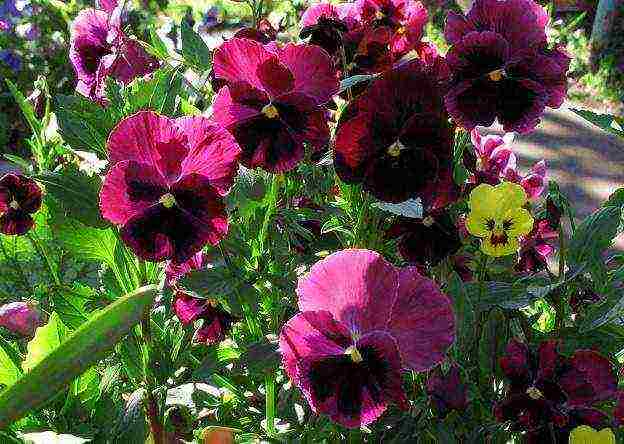 Viola grown in partial shade
Viola grown in partial shade
Viola develops well in cool conditions. Ideal temperatures for her are 10-25 ° C. It withstands, without loss of decorative effect, and short-term cold up to 3-5 ° C.But the heat affects the viola badly, so often in hot summers (especially when grown in sunny areas) there is a break in flowering. The second wave of flowering in this case is possible, but only in autumn.
2. Watering
Viola does not tolerate prolonged drying. Therefore, it needs to be watered often, without waiting for the ground near the roots to turn to stone. But it is not worth planting swamps either! Viola is very demanding on the amount of moisture consumed. With its excess, the roots of the plant begin to rot and rot, the viola dies.
3. Top dressing
In order for the viola to bloom all summer, it needs regular feeding. When growing viola on a balcony, that is, in a closed ground, it is necessary to fertilize the soil every week. If the flowers grow in open ground (on the site), the frequency of fertilization can be reduced to 1 time in 3-4 weeks.
Viola: planting and care at home
Viola at home is best developed on open sunny balconies. Worse - on glazed balconies and loggias. Some growers manage to grow viols even on window sills, but in this case it is necessary that the window be constantly open. The presence of plenty of light and fresh air is a must for growing any garden plant.
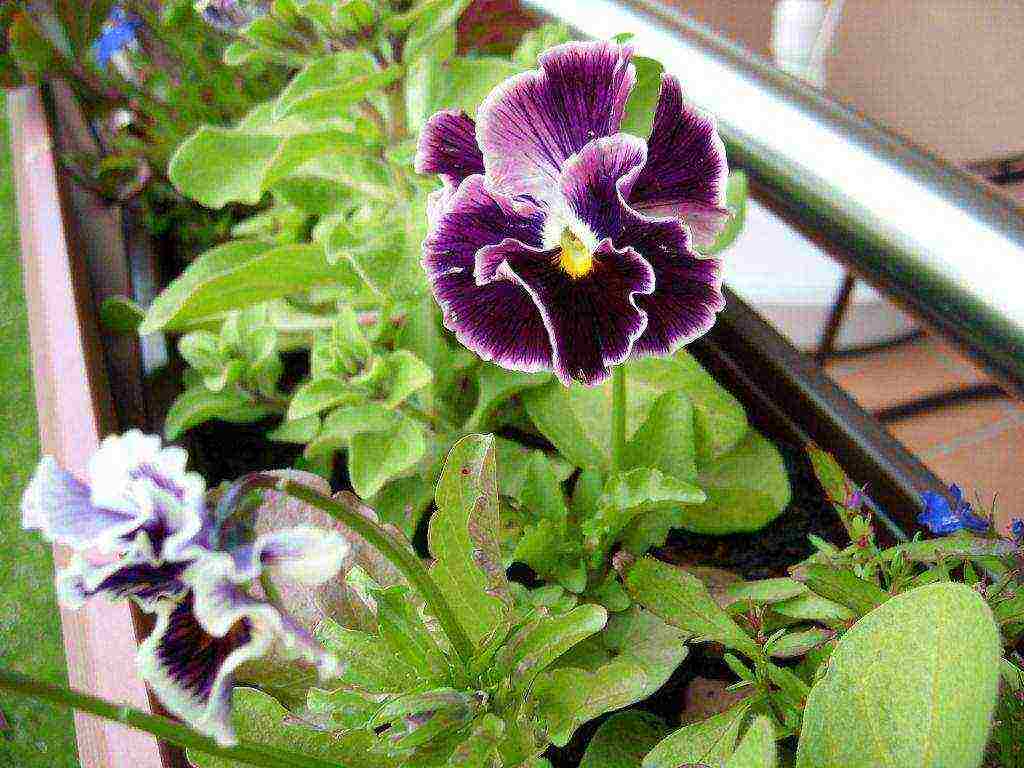 Viola grows well indoors in the presence of fresh air and plenty of light
Viola grows well indoors in the presence of fresh air and plenty of light
Planting viola at home is carried out in flower pots, balcony boxes. Ampel forms - in hanging baskets, flower pots, tall flowerpots on a leg. Any container chosen must have drain holes.
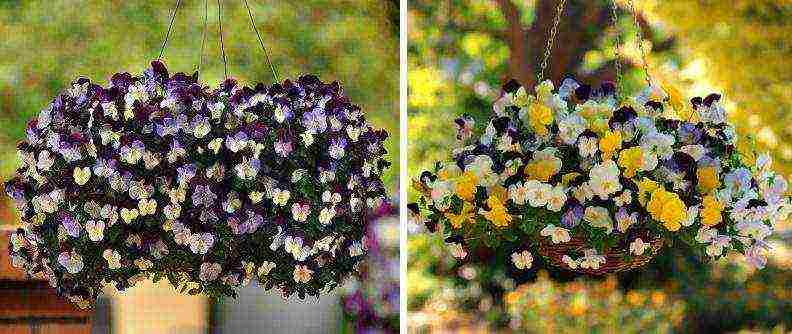 Ampel varieties of viola look spectacular in hanging baskets
Ampel varieties of viola look spectacular in hanging baskets
Since the roots of viols are prone to rotting, special attention should be paid to a good drainage layer when planting. To do this, a layer of drainage material (expanded clay, brick shards, foam) with a minimum thickness of 2-3 cm is poured onto the bottom of the selected container. Soil is poured on top - it must be loose, moisture and air permeable.
 Observe a distance of 10-15 cm between violas, otherwise strong specimens will oppress the weak and force them out of the composition
Observe a distance of 10-15 cm between violas, otherwise strong specimens will oppress the weak and force them out of the composition
Viola seedlings are planted at a distance of 10-15 cm from each other, while at least 1-2 liters of soil should be allocated for each plant specimen.
When growing viols indoors, you need to monitor the regularity of watering. On hot summer days, watering should be carried out 2 times a day - in the morning and in the evening.
The first top dressing is applied 2 weeks after transplanting into the ground. Further, it is necessary to fertilize viols at home every week. Any mineral complex fertilizers for flowering are suitable for fertilization.
During hot days, the viola in a pot can lose its decorative appearance. Most often, the stems turn yellow and dry, the bush falls apart, the flowering becomes less abundant, the flowers fade and decrease in size. Then the viola must be cut. Usually it is shortened by half the length of the stems. But if the bush has already lost any decorative value, pruning can be done radically, leaving 5-6 cm from the branches (leaves must be left on them!). After 2-2.5 weeks, the viola bush will grow overgrown with young shoots and bloom.
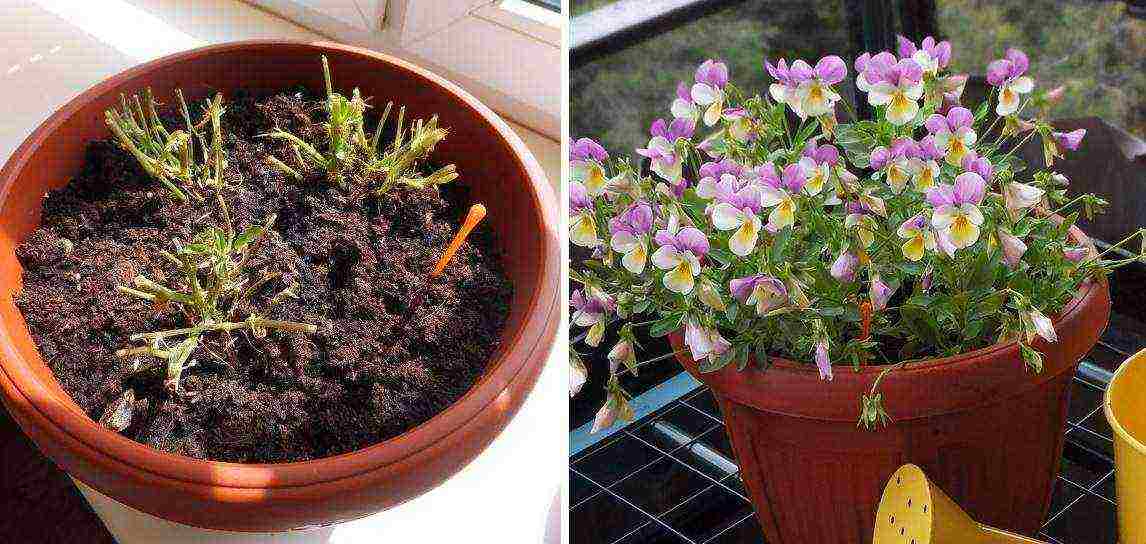 Viola pruning and subsequent flowering: before and after photos Pansies: outdoor care
Viola pruning and subsequent flowering: before and after photos Pansies: outdoor care
In the garden, viola seedlings are planted in late spring, when the threat of night frosts has passed. Although viola is a hardy plant, its seedlings are too tender. Moreover, the one that is grown at home. Therefore, it is better not to risk it and time the planting of seedlings to warm and sunny spring days.
The distance between the bushes of viola is 10-15 cm. It is useful to throw a handful of baking powder (vermiculite, perlite, sand) into each hole dug under the plant, especially if the soil on the site is dense.
Fertilizers for viols growing in the garden can be applied once every 1-4 weeks. On some soils, flowers require fertilization every week, on others - once a month.It depends on the initial fertility of the soil.
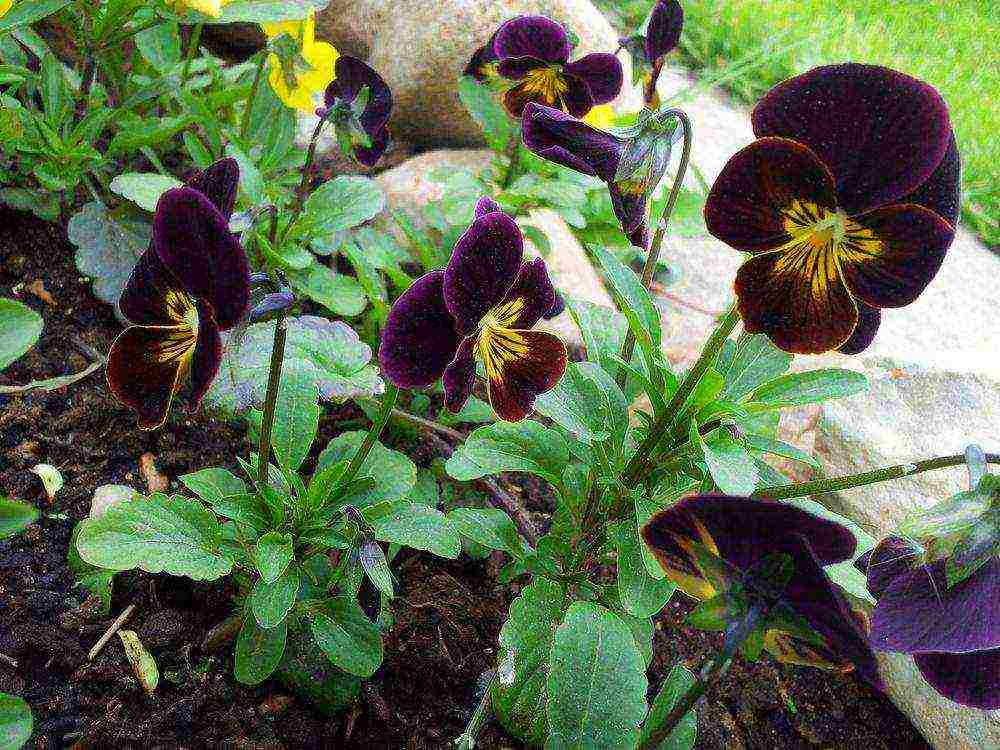 Viola in the open fieldViola in winter: a few nuances about viola winter
Viola in the open fieldViola in winter: a few nuances about viola winter
In winter, it is advisable to cover viols growing in the garden with spruce branches or dry leaves, and in early spring to open so that there is no damping out. The flowering of plants of the second year of life begins already in April, at the same time as crocuses.
Viols grown in greenhouses winter in a different way. Usually their life cycle ends in autumn, with the onset of frost. However, if there is a desire to save the plant for the next year, then why not? You can do one of two things:
Option number 1. Viols are dug out of pots, planted in the ground in August-September. Before frost, the plant will have time to take root and acclimatize. 2-3 weeks before the expected frost, it is advisable not to let such viols bloom, so as not to weaken them. For the winter, cover the plants with spruce branches or leaves.
Option number 2. Bring the pot of viola to a cool, bright room. For example, on an insulated balcony or veranda. The optimum wintering temperature is 5-15 ° C. In the spring, the preserved uterine bushes are cut and new young plants are grown.

Pansies have a special place among the most beautiful early cultivated plants. Their colors can be very different - the color combination is really incredible.
A distinctive feature of the flower is that there is a spot of unusual color and shape in the center.
Consider such questions: how to grow strong seedlings; when is it better to plant in open ground. And also, what diseases are common when caring for viola.
…
With your own hands
After you find the right variety, you need to think about a transplant. The flower is planted on a flower bed with seeds or seedlings. If you want to plant flowers in a flower bed as early as possible, then you need to grow them using the seedling method. In the second year, planting seeds in the ground and careful care of the plant will allow you to get early flowering. The flower is planted in May, making small holes 1 cm deep. 2-3 seeds are placed in each of them.
After the seeds are sprinkled with earth, watered, mulched to retain moisture.
On a note. The first flowers can be seen 20 days after planting, namely in early summer.
Having decided to grow viola seedlings, you can see the seedlings much earlier. Many gardeners are afraid to grow this plant, so they buy ready-made seedlings from the store. But you can prepare the material for planting with your own hands.
Growing from seeds
Next, we will look at how to grow a flower from seeds.when to plant and replant the plant.
Follow these guidelines:
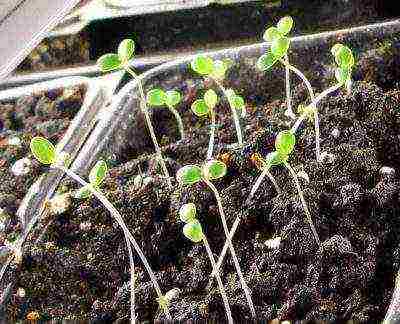 Prepare containers that contain leafy and turfy soil. The second half is occupied by rotted compost.
Prepare containers that contain leafy and turfy soil. The second half is occupied by rotted compost.- Before planting, it is important to disinfect the soil with a fungicide. After drying, you need to make small grooves and put the seeds there, and then sprinkle them with soil. Seedling pots are placed at home in a dark place.
- The first shoots are visible after 2 weeks. When they make themselves felt, you need to put the flowers in the sun. The temperature should be above 10 degrees.
- When more than 2 leaves appear on the plants, transplant them into containers. Then they can be laid out on the balcony.
- Feed the plant every week with flower fertilizer - the best solution is to choose one that is suitable for violets.
- In May, seedlings are planted in open ground.
How to grow?
There is a special soil for violets on sale. A good planting option would be to use peat tablets that fit in plastic cups. However, if it is supposed to breed flowers on the site, then such techniques will lead to high costs.
The soil must be fertile and moist. And, as for the soil, the sandy does not hold water well, and the stony ones are not suitable for growing a flower.
Attention! You need to ventilate containers every day.To do this, lift the film and move the glass.
Otherwise, mold will appear on the soil. The transplant is done in clay pots. This is done 1.5 months after the pansies have been planted. During this period, the rooting of seedlings is carried out.
When grown by seeds, fertilizers are applied under developed bushesbecause the soil is fed just before the seeds are placed in it. In this case, a good option would be the drug Kemira, which is diluted in water and introduced into the soil during irrigation.
Embedding in the ground
Preparing for seed germination. The first option is traditional embedding. According to this scheme, it is believed that the shoots will sprout in the dark:
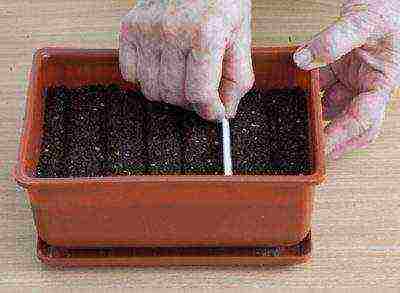 The soil must be plowed through with your fingers to a depth of 1 cm.
The soil must be plowed through with your fingers to a depth of 1 cm.- Seeds are placed in the grooves and sprinkled on them. After they are poured with water and covered with a film in order to create a humid microclimate.
- 2 times a day for 10 minutes you need to open this mini-greenhouse and ventilate the soil. If this is not done, mold will form on the soil.
- The container with seedlings is placed in a warm place. Lighting plays a less important role before the shoots appear. You can put the container in a dark closet or on a windowsill. In this case, the sprouts will appear faster.
There is one important point - viola naturally grows in the dark., therefore, after sowing in a container with seeds, you need to wait until the first shoots appear. It is important to moisten it with warm water and cover with cardboard.
The necessary conditions
Note! The main condition for seed germination and strong seedlings is good lighting.
When there is little light, the seedlings become weak, pale, elongated. 14-16 hours of bright light every day are considered ideal. This is slightly more than adult plants require.
UV lamps are used to provide good illumination. Seeds are often germinated at a temperature of 15-18 degrees. It should be borne in mind that at lower temperatures, the growth process will slow down, but the seedlings will be hardy, strong, seasoned.
The soil should not dry out, but stagnation of water should not be allowed. The substrate must be moistened, watering and spraying is carried out from a spray bottle. Grown plants are watered from a watering can with water at room temperature. Adult seedlings should be watered from the pallet - this will ensure the rapid development of the root system.
Peculiarities
Viola is an unpretentious and hardy plant with good flowering. It can be planted in lighted areas, and reproduction is carried out by self-seeding. Pansies grow on non-greasy, fertile soils. When grown in a shaded area, the flowers become very small. Features of care consist in observing the following steps:
- Moderate watering without waterlogging.
- Fertilizing twice a day.
- Loosening the soil and weeding.
Seedling
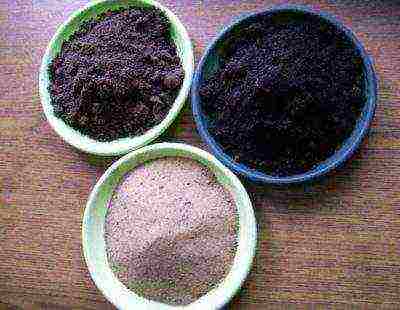 The viola sowing period is from 1 to 10 March. The mortar can be used ready-made, which you can buy in the store. In order for the roots of the seedlings to develop quickly, a little sand should be added to the soil. you also you can prepare the soil for seedlings with your own hands:
The viola sowing period is from 1 to 10 March. The mortar can be used ready-made, which you can buy in the store. In order for the roots of the seedlings to develop quickly, a little sand should be added to the soil. you also you can prepare the soil for seedlings with your own hands:
- Mix turf and garden soil, peat, sand and humus.
- Sift all ingredients.
- So that the seedlings are not amazed by the black leg, you need to steam the mixture in a double boiler for about an hour. So she will be cleansed of diseases and weeds.
- Fill a bowl with the soil mixture and compact it.
- Spread the seeds over the surface.
- You can do this with paper.
Care advice
Violets grow well in soil consisting of turf, sand and peat. Since pansies are an unpretentious flower, you do not need to take special care of them. It is only necessary to loosen the ground from time to time, remove flowers that have withered, apply mineral fertilizers and water. First you need to choose the right location on the site.
Important! Viola can die in open sunlight, and in the shade the flowers will be small and inconspicuous, so you should choose a place with diffused light.
Leaving it for the winter, do not forget about the need to cover the plant with spruce branches, and remove it in the spring. The same rules should be taken into account if you decide to grow plants on the southern balcony.
Top dressing for pansies is applied regularly - at least twice a season. The main feeding is carried out when the plant begins to pick up buds. The next feeding is carried out with abundant flowering. At the same time, fertilizer Agricolka-7 is used.
For feeding, mineral fertilizers are needed, which include nitrogen, potassium, phosphorus, and other trace elements. After planting, the seedlings are fertilized with saltpeter and superphosphate. Fresh manure is not applied to the soil where pansies live.
Training
Plant seeds can be sown in autumn, namely in September. They will overwinter April and begin to bloom. Early sowing is done in February-March. Summer sowing in June suggests that the pansies will bloom in the fall.
There are two ways to plant and prepare seedlings:
 Sowing into soil, which includes humus and peat. The pots are placed in a warm place. They need to be covered with a film, and then lifted up every day.
Sowing into soil, which includes humus and peat. The pots are placed in a warm place. They need to be covered with a film, and then lifted up every day.- When embedded in the soil, grooves are made, the width of which is 0.5 cm, and the distance between them is 2 cm. The sowing is covered with a film and kept closed, periodically ventilating the area.
Seedlings germinate in about 2 weeks, however, sometimes it happens later - it all depends on the type of seed. How to properly plant seedlings when planting in soil?
You can use the grafting method:
- Green shoots are cut from the bush.
- They are planted in the shade at a depth of 1 cm, and then watered with water.
- Roots appear in 4 weeks.
In the open field
After planting in open ground, the seedlings need to be slightly loosened and systematically moisten. Top dressing will get rid of harmful insects.
Reference. During the period of abundant flowering, it is necessary to remove the buds that have faded - it is important to give the opportunity to develop new buds.
This procedure will prevent the fruiting of plants after which the pansies stop growing.
When do they bloom?
Plants are often planted in the spring. In this case, it will be possible to transfer them to the ground at the end of June or at the beginning of July. Seed shoots appear in 2 weeks. At the end of August, you can proceed to diving seedlings - planting plants at a distance of 20 cm from each other.
If you cut the plant in the spring, the pansies will bloom in the summer. If you do this in the fall, then flowering will occur in the spring of next year.
If you plant in May, the viola will bloom in the fall, and this can adversely affect wintering - the plants do not tolerate frosts well. For the winter, young plantings are covered with mulch to avoid bulging seedlings.
Diseases
These include the following:
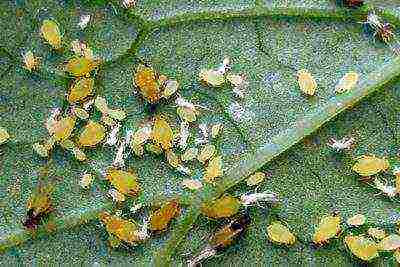 Plants stretch out, while flowering is reduced. This is due to the excess nitrogen in the soil. The best solution would be to use complex fertilizers, which contain microelements that increase decorative effect and enhance immunity.
Plants stretch out, while flowering is reduced. This is due to the excess nitrogen in the soil. The best solution would be to use complex fertilizers, which contain microelements that increase decorative effect and enhance immunity.- Aphid. She sucks the sap from the plant. It is important to spray the plants with onion husk infusion.
- Gray rot. Leaves, flowers and stems are affected. It is necessary to spray the plants with copper chloride.
- Spotting. This disease leads to the death of the leaves. The plant loses its decorative effect and does not bloom so abundantly. The method of fighting is the same as with gray mold.
- Fungus. The root system rots, so it is important to disinfect the soil and adjust the irrigation regime.
- Powdery mildew. It appears on buds, stems and leaves. The affected areas dry up and the flowering time becomes less intense. Soda ash and soap, a solution of a copper-soap preparation will help to overcome this.
As you can see, pansies are a flower of incredible beauty, which must certainly take place on the windowsill of your house or in the garden. He will delight with his beauty for a long time, if you provide him with the right conditions and good care.
Useful video
Pansies. Growing and care:
Many growers love to grow pansies: these plants with miniature delicate flowers at first glance win the affection and love of so many. Their shades are very diverse, ranging from snow white to black. The most popular varieties are those in which the flowers have a two-tone color. In the article we will talk about growing pansies from seeds and seedlings, give advice on when to plant, what fertilizers to use, how to propagate.
Description of pansy flowers
In another way, these marvelous perennial flowers are called Vittrock's viola or tricolor violet - this is how experts separate these types of flowers. The tricolor violet blooms with small flowers and can reproduce by self-seeding. If you do not weed out excess plants, the violet can capture not only the entire area, but also neighboring ones.
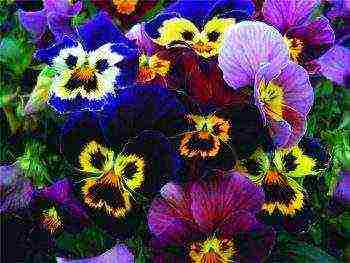
Pansies can be grown in a variety of ways, including on site and at home.
Viola Vittroka cannot boast of such characteristics, therefore it must be propagated by seeds in order to maintain the decorative effect of this type of flower culture and ensure good flowering. It is the Viola Vittroka that decorates windows, balconies, hanging pots, gardens and other places of the plots.
In height, these plants do not grow more than 30 cm. They have an erect main stem, which feeds on a fibrous root system. Young bushes are compact in size, which then become spreading. The diameter of single flowers, located on short peduncles, is about 7 cm. Pansies bloom in early April. Read also the article: → "How to grow pansies."
Variety of varieties of pansies (review)
Breeders work tirelessly to develop new varieties of these amazing flowers. Moreover, the new hybrids are more resistant to disease and adverse weather conditions.
| Variety name | Description | Plant feature |
| "Snow Maiden | Bush height 28-32 cm | More than 25-30 large flowers (up to 6 cm) can bloom on one bush at the same time, |
| "Little Red Riding Hood" | Bushes up to 25 cm high | The buds are large, bright red, there is a dark spot in the middle |
| "Magic March" | Hybrid | The flowers are velvety, purple. The diameter of the flower is 5 cm.In the process of flowering, the flowers change their color and turn black |
| "Winter sun" | Flowers diameter - 12 cm | Buds - two-tone, with a pale yellow top and a chocolate brown bottom |
| "Jupiter" | Tricolor variety | The upper petals, which are purple in color, have a white border. The lower ones are one-color, white-pink. |
| Fire King | Bush up to 20 cm in height. It is a small-flowered variety. | More than a hundred beautiful yellow flowers can bloom on each bush at the same time. |
Pansies in a hanging planter for plot decoration
How to grow pansies
There are usually no difficulties in growing pansies. This can be done either by cuttings or by planting seeds. Moreover, the seeds can be planted in the ground or grown into seedlings. If pansies have sprouted from fallen seeds, they are unlikely to become a decoration of the site, since they are then re-pollinated. Because of this, plants lose their specific features, they may change the size of flowers and their color.
To prevent this from happening, all plants that can be pollinated must be planted at a distance from one another to maintain the purity of the variety. Many growers, having planted their favorite variety of flowers once on the site, collect seeds from them. For this, strong specimens are selected and after the boxes turn yellow, cut them off carefully and shake out the mature seeds on a napkin.
But, at the same time, you need to be very careful: from overripe capsules, seeds can easily "escape", spilling out directly on the ground. It is impossible to find them later: they are very small (one gram is more than 1000 pieces) and it is unlikely that they can be detected.Read also the article: → "How to collect flower seeds."
Choosing a place for flowers
- Pansies belong to heat-loving crops, therefore, well-lit places should be chosen for them on the site.
- It can be planted in slightly shaded areas, but it's not worth it in partial shade - the viola will only throw out small flowers, and it will grow for a very long time. But pansies planted in a sunny or partially shaded place delight their owners with large flowers of juicy colors.
- In the southern regions, it is not worth planting viola in well-lit places - in the midday heat in summer they will wither. To prevent this, you can use a removable shading option or apply evening and morning watering.
Blooming pansies close up
Not only partial shade does not like pansies, but also excess moisture. For this reason, they are not planted in lowlands, damp places or where water stands for a long time in spring or after rains - plants are likely to die from the fact that the root can rot or in winter, when the moist soil freezes very deeply, the root system frost damage.
The soil is best neutral, fertile, loamy. If the soil is sandy and poor, its composition can be improved. For this, about 4-6 kg of plant compost are introduced per 1 m / sq. Experienced flower growers strongly advise doing this, otherwise the pansies will become smaller, which will affect their decorative effect.
Open ground: cultivation features
In open ground, seeds are planted in early to mid-summer. Of course, in the year of sowing their flowering will not work, but in early spring next year, the pansies will bloom profusely. The planting process is as follows:
- A place is allocated for a nursery.
- Prepare the soil - loosen it, fertilize it and water it.
- Sow seeds.
- When shoots appear, they must be dived. You need to transplant when the first 2-3 leaves appear. It is necessary to transplant immediately to the place that is allocated for their constant growth. Leave 25 cm between the bushes.
Tip # 1. In order for the roots to form better, when transplanting young plants, you need to pinch the root. To do this, remove a third of the central root.
How to grow pansy seedlings?
In order for the plants to bloom already this year, it is recommended to sow seeds in the first days of spring. Experts advise to do it like this:
- Prepare special small containers that have drainage holes. If they have already been in use, then they need to be washed well, removed plaque and spilled with boiling water and soda.
- Fill them with prepared substrate.
- Spill with potassium permanganate and set aside for a day.
- Spread the seeds on the surface of the substrate, at a short distance from one another. For this, grooves are prepared with a depth of no more than 1 cm.
- Sprinkle a little and moisten with a sprayer.
- Close with glass. If there is no glass, you can put containers with seedlings in plastic bags and put in a shaded warm place. This will create the greenhouse effect that is so important for germinating seeds.

Growing viola seedlings at home
- After the sprouts appear, the containers are moved to the windowsill. Usually, heating radiators are located under the windows, so you need to make sure that the seedlings are not very hot under the coating (film or glass).
- After the appearance of real leaves, the plants dive. At the same time, they are transplanted into individual containers. For example, in cups.
- In April, it is necessary to start hardening the sprouts, taking the cups to the balcony, veranda, but best of all - to the street.
- With the onset of heat (late April - early May), the viola is planted in open ground.In a month you can admire the first abundant flowering. It is necessary to plant so that the top of the earthen coma is flush with the ground surface. It is impossible to deepen, or vice versa, to raise an earthen lump higher - in the first case, the plant will not bloom soon, and in the second, it may die from drying out of the roots.
Tip # 2. It is necessary to plant young plants so that the top of the earthen coma with the root is at the level of the soil surface.
Growing pansies on the balcony
Many housewives try not only to make the house cozy and beautiful, but also to equip balcony spaces so that they do not serve as a warehouse for necessary and unnecessary things, but are one of the most beautiful places in an apartment or a country house. Pansies do a great job at this: they can be grown as annuals.
So that they bloom as early as possible, you can sow seeds in containers located on the balcony, cover with foil and leave until spring. With the onset of heat, the film is raised for the day, and at night the raised seedlings are again covered. Then you need to thin it out and wait for flowering.

Many grow pansies at home.
If you use the seedling method, then in the middle of summer the viola will begin to bloom violently. Of course, in annual plants, the flowers and the bushes themselves are slightly smaller, but they do not become less beautiful from this. But, so that the flowers do not wither, you need to choose the right containers for them. It can be:
- Wooden boxes.
- Ceramic pots.
- Plastic containers.
The main thing is that they have a size corresponding to the plant, about 1 m long, 25 cm deep and wide. At the bottom, there must be a drainage hole with a diameter of about 1 cm. It will serve simultaneously to remove excess water and air intake. After that, drainage is laid, covered with nutritious soil, leaving 1.0-1.5 cm to the top. Next, the containers are placed on the floor, attached to the parapet or the outside of the window sill. Read also the article: → "Flowers for growing on the balcony."
How to care for pansies?
The most important thing is watering. Its intensity depends on the type of flower. Plants with large, strongly colored flowers need a lot of moisture, so you need to water more often and more abundantly. But you can water only when the soil dries up slightly. If the soil remains wet, even if the flowers have not been watered for a long time, you do not need to do this - the roots are guaranteed to rot from stagnant water. In the summer, so that the pansies do not suffer from the heat, it is useful to spray them every morning.
Experienced flower growers say that it is not necessary to water the viola every day (except in very hot weather), but every other day. After watering or rain, be sure to loosen the soil in the area with viola.Pansies really do not like sudden changes in temperature. If there is little snow in winter, at very low temperatures the plants will freeze. Flowers can also die in spring - in those days when there are frosts at night, and the sun warms up strongly during the day.
In order to prevent the death of flowers in winter, you can additionally cover them with snow; in the spring, you can protect plants from frost using ordinary plastic wrap, equipping a kind of greenhouse from it for the night. When the pansies begin to bloom profusely, faded buds must be removed from the bushes in a timely manner. This will help to appear and bloom new faster and will not allow fruiting - after it the pansies no longer bloom.
No matter how properly they looked after the flowers, you cannot do without feeding.
What fertilizers are suitable for flowers
It is unacceptable to use fresh manure for feeding pansies in any case: it will burn the roots, and the plants will not survive. It is undesirable to use nitrogen fertilizers. It is best to apply mineral fertilizers to the soil, which contain nitrogen, phosphorus and other necessary trace elements. They are brought in once a month. Experts call the following drugs the most acceptable drugs:
| Name | Release form | Impact | Application feature |
| "Plantofol" | Crystalline powder | Provides plants with various trace elements | Foliar top dressing |
| "MicroMix Root Feeder" | Water soluble granules | Contains all the necessary substances in a chelated form | Introduced when watering |
| "Bio Master: Violet" | Granules or powder | Contains bioactive substances and essential elements | Increases the stability of flowers, mobilizes their name system |
| "Annushka" | Liquid | Has a balanced composition of macro- and micro-substances. | Flowers can be sprayed with solution or applied under the root |
| Agricola 7 fertilizer reviews Agricola |
Granules | Prolongs flowering time, increases the number of flowers | For watering or spraying |
Several important nuances in the care of a viola
Amateur gardeners often make the same mistakes, which negates all the efforts and works of this undemanding, but very delicate flower. What do you need to know to avoid them?
| Action | What does it lead to | Why is happening |
| Late germination of seeds | Plants do not bloom | Pansies do not like heat, as they are not tropical plants. |
| Germinating seeds at high temperatures | Seedlings when planted in the ground may die | Overheated plants are very weak and will die or hurt with any temperature change |
| Using non-sterilized seedling pots in which other flowers have already been grown | There will be no seedlings | Sprouts of pansies can destroy thrips, which love to feast on them. |
Planting pansies with seedlings, the plant takes root faster
Heading "Questions and Answers"
Question number 1. Can pansies be fertilized with natural fertilizers, namely compost and humus?
No, this cannot be done, in no case. this fertilization option is absolutely not suitable for pansies. This is due to the fact that feeding the plant in this way, you can damage the roots of flowers - they can simply burn. It is better to use chemical dressings.
Question number 2. How to grow pansies at home?
First, it is worth choosing a suitable location. If you will be growing flowers on the window, you should take care of the temperature, which should not constantly and abruptly change. Otherwise, in fact, the care and method of growing is no different from the standard - for a personal plot.
Question number 3. I planted pansies, but they don't bloom, why?
Chances are you expect them to bloom the same year they are planted. Unfortunately, even with very good care, pansies take time. Therefore, planting a plant requires patience and time. next spring you will definitely see beautiful flowers.
Rate the quality of the article. We want to be better for you:


